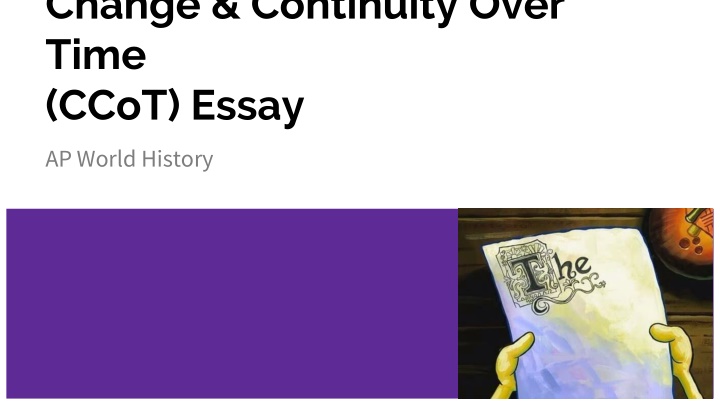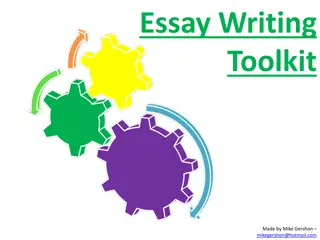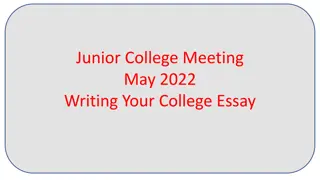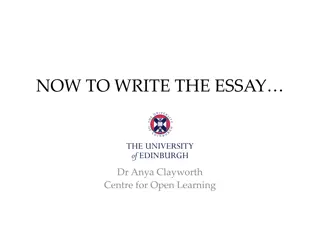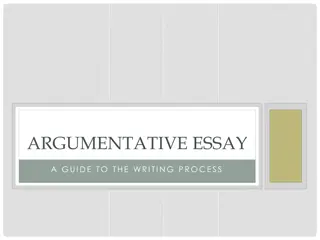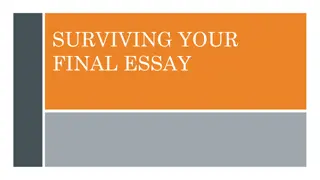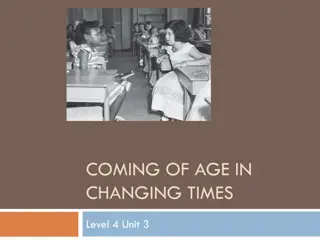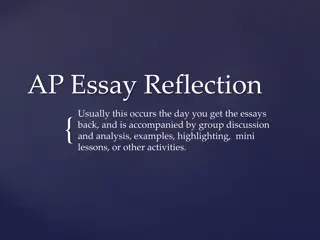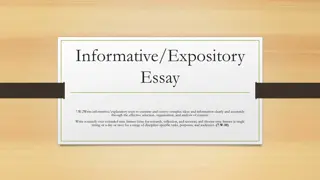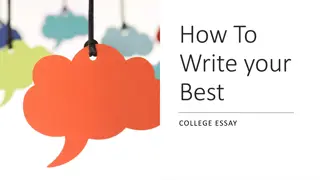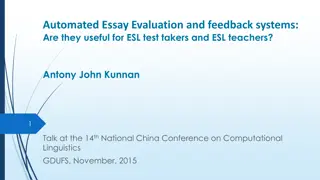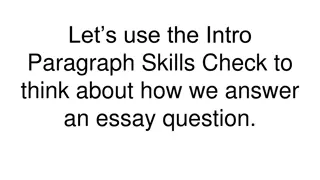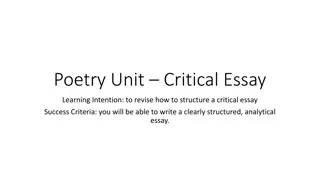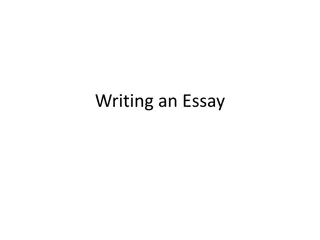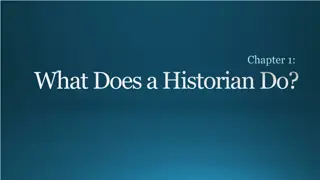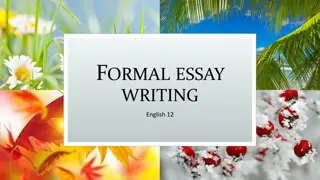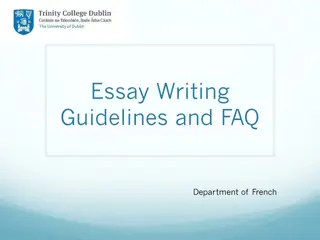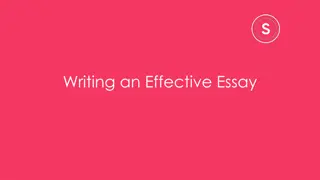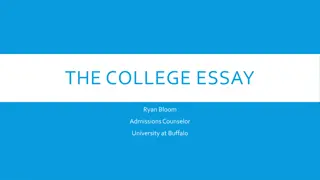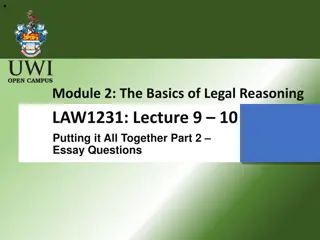Mastering CCoT Essay: Analysis of Changes & Continuities
Dive into the intricacies of Change & Continuity over Time (CCoT) Essay in AP World History. Uncover major historical shifts, identify underlying causes, and analyze persistent factors. Explore themes like technology, trade, culture, migrations, and more across specific regions. Learn to craft a thesis pointing out changes and continuities, back it with evidence, and address all aspects of the prompt. Understand the rubric criteria for Basic Core, Competence, and Excellence levels, and grasp the art of writing a comprehensive CCoT essay through effective analysis and historical context.
Download Presentation

Please find below an Image/Link to download the presentation.
The content on the website is provided AS IS for your information and personal use only. It may not be sold, licensed, or shared on other websites without obtaining consent from the author.If you encounter any issues during the download, it is possible that the publisher has removed the file from their server.
You are allowed to download the files provided on this website for personal or commercial use, subject to the condition that they are used lawfully. All files are the property of their respective owners.
The content on the website is provided AS IS for your information and personal use only. It may not be sold, licensed, or shared on other websites without obtaining consent from the author.
E N D
Presentation Transcript
Change & Continuity Over Time (CCoT) Essay AP World History
Whats the goal of this essay? It deals specifically with analysis of continuities and changes over time. Change: You have to recognize major changes in history, and identify and understand what causes those changes. Continuity: You have to recognize factors which remain the same throughout history, and identify and understand factors that allow this. It addresses a particular theme. Technology, trade, culture, migrations, the environment, politics It also addresses a particular region (but usually, you get to pick) You have to analyze what changes and what stays the same for an aspect of history,
1. Write a thesis that points out changes & continuities over time. What the Directions Mean 2. Support it with evidence. 3. Answer all parts of the question. 4. Show the change over time, using relevant history. a. Contrast how things turned out with how things were originally, and weigh what changed vs. what stayed the same.
The rubric: Basic Core: Competence Expanded Core: Excellence 1. Has acceptable thesis. (Addresses global issues, correct time period. Must include change and continuity.) - 1 point 2. Addresses all parts of the question, though not necessarily evenly or thoroughly. - 2 points 3. Substantiates thesis with appropriate historical evidence. - 2 points 4. Uses relevant historical context effectively to explain change over time and continuity. (How are changes and continuities in this specific topic influenced by global historical movements or processes?) - 1 point 5. Analyzes the process of change over time and continuity. (Why do things change or stay the same?) - 1 point Expands beyond the basic core of 1-7 points. A student must earn 7 points in the basic core before earning points in the expanded core area. Has a clear, analytical, and comprehensive thesis Addresses all parts of the question comprehensively Provides even and ample evidence of change and continuity Analyzes both change and continuity throughout the essay Provides ample world historical context Provides extended analysis of change or continuity (extra reasons why things change or stay the same)
Step 1: Process the Prompt Read the question and figure out what you re expected to do. Circle the key phrases: What: Changes & continuities in Participation in interregional trade (trade with other regions) What (topics) Who (societies or regions) Who: One of the three choices (Latin America, Sub- Saharan Africa, Southeast Asia) When (dates) When: 1500 to 1750
Step 2: Brainstorm your Info The topics you discuss (what changes & stays the same) will be based on the prompt. Sometimes they ll give you categories, other times you can create your own. SCRIPTED: Social, Cultural, Religion, Interactions with Others, Politics, Technology, Economics, Demography (Population) Try to get 3 topics. 3-sentence thesis
Step 2: Brainstorm Your Info Beginning: (The baseline ) Middle: What has changed about this topic? What has stayed the same? Why? End: What has changed about this topic? What has stayed the same? Why? What is the topic like in this region at the beginning of this time period? Set it up so you can explain the changes 1500
Step 2: Brainstorm Your Info Beginning: (The baseline ) Middle: What has changed about this topic? What has stayed the same? Why? End: What has changed about this topic? What has stayed the same? Why? What is the topic like in this region at the beginning of this time period? Ex. Changes - European nations (Spain, Portugal) get into trade More military use in SE Asia (Portugal) Continuities - Trade between India, China, Arabs for luxury goods Ex. Changes - Dutch dominate spice trade, English begin to control India Europeans control major trading ports & demand tribute from locals Continuities - etc. Set it up so you can explain the changes Ex. In SE Asia, part of Indian Ocean trade network -- peaceful trade between India, China, Arabs 1500
Step 3: Write a Thesis/Intro 1 sentence -- set up the time period/historical background (using the prompt) 3 sentences - 1 for each of your 3 main arguments Make sure to address continuity and change See the whiteboard for examples
Step 4: Write the Essay Each body paragraph is a snapshot of time. What s going on with your topic in this area during this part of history? (You can think of it like the beginning paragraph, the middle paragraph, and the ending paragraph.) In each body paragraph, talk about each of your three themes/topics: Topic Sentence Theme 1 - what changed or stayed the same? Why (analyze)? Theme 2 - what changed or stayed the same? Why (analyze)? Theme 3 - what changed or stayed the same? Why (analyze)? For each theme, prove it -- give historical evidence (facts)
Change & Continuity Words Now Persistent Gradually Sustained Later Enduring Eventually Ongoing Immediately Constant Until that time Sustained Up to that time Maintained Formerly Uphold/upheld As things evolved Preserve
Keep this in mind while you write: You have to use concrete details and analyze based on the prompt. You can t just say Prior to 1948, the Jewish people had no homeland. In 1948, Israel was established. Use facts to show the historical development of the change: In the early twentieth century, few people saw the need for the establishment of an independent Jewish state. However, as a result of the genocide of Jewish people during World War 2, support for the the establishment of such a state began to grow, leading to the creation of Israel in 1948.
